Day 2 of a three-day long weekend of tours today, and we headed down to the Brecks for our last day. The weather started to brighten up nicely as we drove down, with some breaks in the cloud, but there was a cold NE wind all day.
We started at Lynford. A Nuthatch was piping from the top of the larch trees as we walked into the arboretum and we had a good look at it in the scope. A Song Thrush was in full song. We could hear several Siskins and see them zooming around through the trees. Several Marsh Tits were calling and one appeared in the bare branches above us.
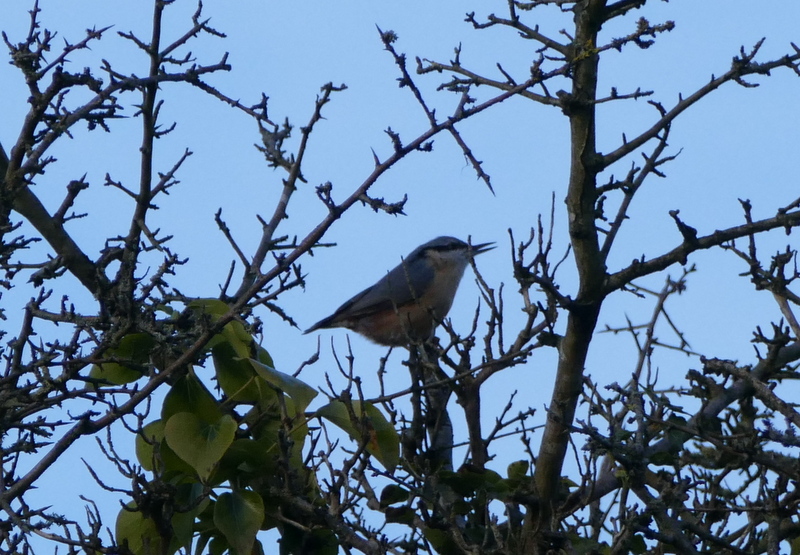 Nuthatch – this one piping later in the afternoon
Nuthatch – this one piping later in the afternoon
The feeders were looking sadly empty today – even the cage of fat balls had all but run out – and there was no seed left on the ground. Consequently, there were not many birds here this morning. A couple of Chaffinches were down in the leaves at the back and a few tits came in to try their luck. The Hawfinches have not been seen here with any regularity this season – perhaps there is more food available elsewhere in the forest this year or perhaps they have been put off by an increase in trapping and ringing activity. We decided to make our way round the arboretum.
We could hear and see all the usual birds going about their business in the arboretum – Goldcrests and Treecreepers singing. But it was a little subdued around in the trees in the cold, despite the fact that we were mostly sheltered from the wind. Down at the bridge there was a little bit of food left out and a steady stream of Nuthatches and tits were flying in to feed. It gave us a nice chance to look at Marsh Tit and Coal Tit and get to grips with them. The peanut feeder was still half full and proving particularly popular today with an absence of food elsewhere – at times it was besieged with tits queueing up to get in.
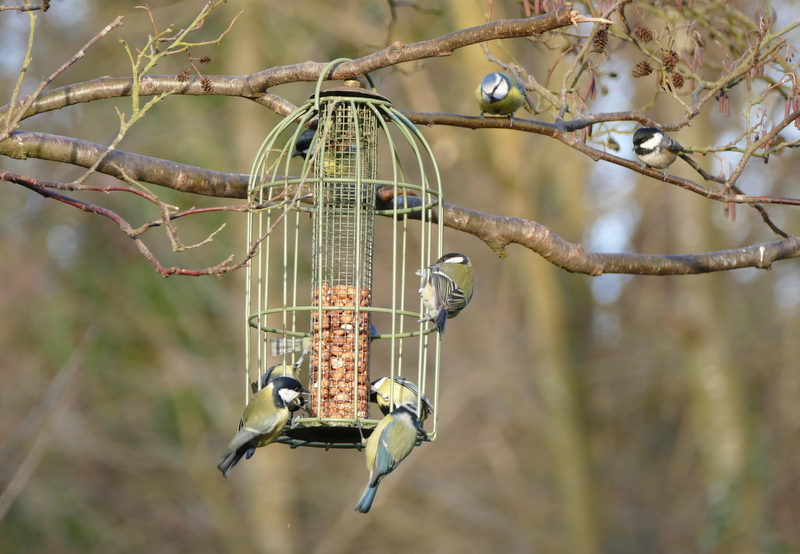 Great, Blue & Coal Tits – queueing to get to the peanuts
Great, Blue & Coal Tits – queueing to get to the peanuts
There was no sign of any Hawfinches around the paddocks, although this is not generally a good time to look for them there so we didn’t waste much time looking. We had a walk down around the lake. A Little Grebe was calling and we saw it diving in front of the reeds. It was starting to get into breeding plumage, with the creamy yellow spot at the base of the bill now showing up nicely, but still lacking a little brightness to the rusty face and black cap.
There were lots of Gadwall and Mallard on the lake as well, plus a pair of Canada Geese and a lone Greylag. The resident pair of Mute Swans are starting to get aggressive with the other wildfowl and the cob attempted to chase off the Canada Geese, before shepherding the pen away down the lake. A Kingfisher called and flashed through where the trees are thickest, just where we couldn’t get a good look at it. We thought it might have landed but there was no further sign.
 Mute Swan – aggressively defending its patch now
Mute Swan – aggressively defending its patch now
We decided to move on and made our way deeper into the Forest. We walked down a ride to one of our favourite clearings. We could hear a Woodlark singing as we walked, but couldn’t see it through the trees. It was sheltered in the forest but when we emerged into the open, we realised just how strong – and cold – the wind was. This is the time of the year when Goshawks display, and that was the main reason why we were here, but they tend to like a bit of warmth in the air – something they would be lucky to get today!
When we arrived there were a couple of friendly faces there and we were told the Goshawks had already been up, a positive sign. We didn’t have to wait very long. We just got a glimpse of a very ragged young female as she disappeared behind some trees, but fortunately she then circled back to the edge of the clearing where everyone could see her. She circled over the edge of the trees towards us – we just managed to get her in the scope. Browner above than the grey of an adult, and black-streaked buffy underparts rather than barred on a white background, she had several wing feathers missing creating big gaps in the wing tips – a bit early to be moulting. A second calendar year female, born last year.
As she circled towards us, another Goshawk appeared above her, higher up in the sky. This time an adult, much paler below and light grey above. It looked noticeably smaller than the young female – an adult male. The two circled over the forest for a short while, drifting away from us, then the male suddenly closed his wings and dropped like a stone towards her, pulling up at the last minute. This was the resident male, seeing a roaming youngster off his territory. She got the message and started to fly away more strongly, but he continued to chase after her. It was great to see the two together – to see the appreciable size difference between the two sexes.
 Goshawk – too slow with the camera today! Here’s one from recently
Goshawk – too slow with the camera today! Here’s one from recently
After some great views of the Goshawks, we decided to turn our attention to Woodlarks. It was rather quiet out in the clearing today – perhaps not surprising with the wind whistling across. A Skylark fluttered up singing, flashing its white outer tail feathers, but didn’t get too high off the ground before dropping down again. We heard a Woodlark singing but we looked up to see it flying over high, before dropping down away behind the trees. There are normally a couple of pairs of Woodlark here, but they seemed to be feeding deeper in the trees today, presumably along the edge of the more sheltered rides. A pair of Stonechats were more adventurous – perched up on the fence.
As we walked back across the clearing, we heard Woodlarks calling and one of the resident pairs dropped down into the clearing. One of them perched up in the open for a minute or so, looking round, while the other, presumably the female, fed down in one of the furrows. We all got a good look at it through the scope, but they took off again just as the cameras came out and flew off over the forest, again dropping down out of view somewhere more sheltered.
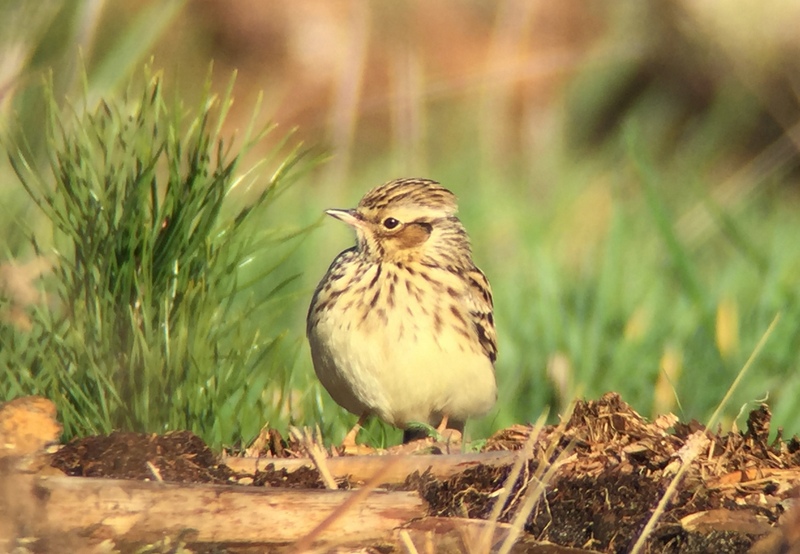 Woodlark – a recent photo from the pair in the clearing
Woodlark – a recent photo from the pair in the clearing
We retreated to the more sheltered side of the clearing, in the hope that we might get some more views of the Goshawks. The weather brightened up a little and the activity of the local Common Buzzards increased. A pair circled up low over the trees ahead of us and we could hear a third Buzzard calling away to our left. As it just broke above the tree line, a Sparrowhawk appeared with it. The Sparrowhawk flew across with bursts of rapid-fire wingbeats interspersed with glides, very different from the more powerful Goshawks we had been watching earlier. Size can be very difficult to judge on a lone bird in the sky, but next to the Buzzard, we could see just how small the Sparrowhawk was.
Despite being partly sheltered by the trees, it was still cold and exposed, so we decided to walk back. On the way, we came across another pair of Woodlarks in a more sheltered corner. One perched up nicely for us on a fence for a few seconds, before dropping down to feed. We could see the two birds down on the ground, but they were hard to follow down in the thick vegetation and in and out of the furrows. Eventually they flew back out across the clearing as we approached.
Banks of cloud were coming and going and as the sky brightened a little again, another Goshawk appeared briefly low over the trees, another adult, before powering away from us.
We stopped for lunch and, while we were eating, news came through that the Great Grey Shrike had reappeared at Grime’s Graves. So, once we had finished, we headed round there to look for it. Unfortunately, by the time we got there, it had disappeared again. Very frustrating! We thought it might be keeping low in the wind, but despite searching all around the area, there was no sign. We wanted to make sure we had enough time to catch up with the Hawfinches, so we needed to cut short our search. A couple of friends were also looking for it and kindly promised to let us know if it reappeared – we could always come back if need be.
We drove back to Lynford and walked out along the path. The area around the feeders was still quiet and nobody seemed to have seen any Hawfinches there or down at the paddocks this afternoon. There were still lots of tits and Nuthatches feeding around the bridge as we walked past. We carried on down to the paddocks and had a quick scan of the trees. All seemed to be very quiet out in the open. A Jay perched up in the afternoon sun – it seems to like this particularly tree at this time of the day!
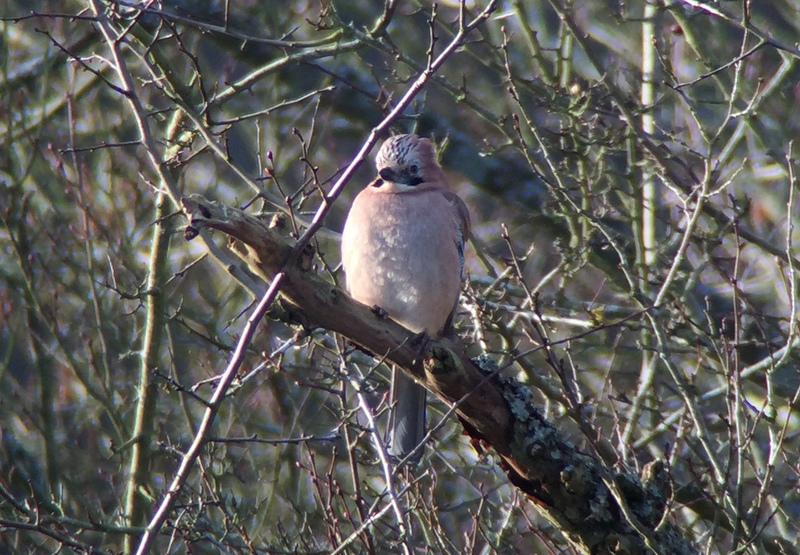 Jay – perched in the afternoon sun again
Jay – perched in the afternoon sun again
We walked a little further along, and scanned the trees again, and this time we picked up a Hawfinch in the tops. After we lined up the various scopes onto it, we realised there were actually two Hawfinches on two different trees we were looking at! They were sitting up enjoying the late afternoon sun, rear onto us so we could see the white tip to their tails and bold grey shawl round the nape. We worked our way further round so we could get them side on.
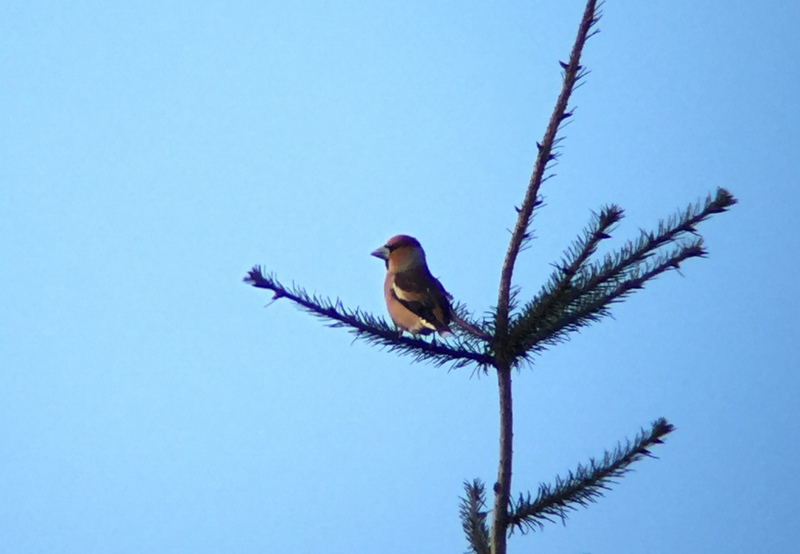 Hawfinch – we found two enjoying the late afternoon sunshine
Hawfinch – we found two enjoying the late afternoon sunshine
From the other side, we could still get an angle on one of them through the trees, a smart rich chestnut male Hawfinch. He was positively glowing in the late afternoon sunshine! We could see his huge nutcracker of a bill, neatly outlined with black continuing down to a smart black bib. We could even see the odd-shaped inner wing feathers. Then, once we had all had a really good look at him, he dropped down into the trees out of sight. We turned and a Kestrel was perched in the hawthorns nearby, also enjoying the afternoon sun.
 Kestrel – also perched in the sunshine
Kestrel – also perched in the sunshine
We walked back to the car park and continued on to the gravel pits beyond. Out on one of them, we could see a scattering of Gadwall and Tufted Duck, plus a few Coot, Canada and Greylag Geese. A couple of other ducks were swimming more unobtrusively round near the more overgrown far edge, the male shining pale in the low sun. A pair of Goosander. We got them in the scope and could see the drake was actually off white with a pale salmon pink glow, the female greyer, with a sharply contrasting rusty red head and white chin. They swam quietly in towards the edge and disappeared into a secluded bay out of view.
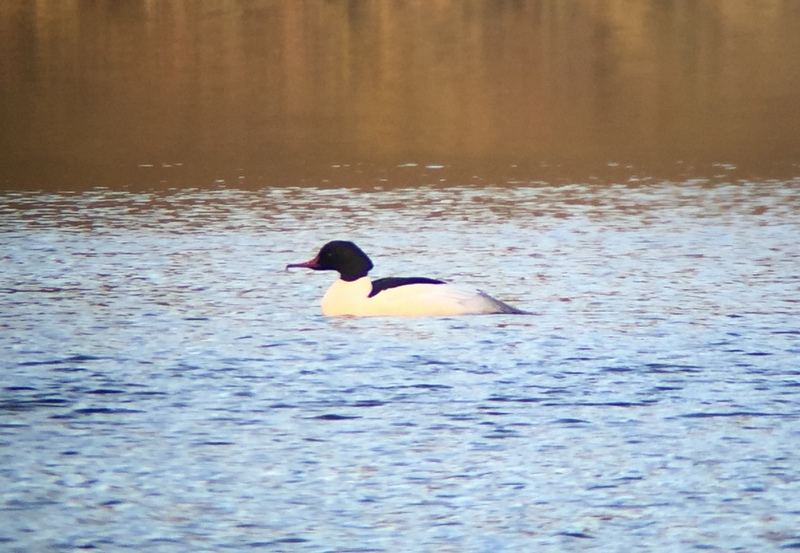 Goosander – a smart drake
Goosander – a smart drake
It was time for us to call it a day too. Despite the nagging cold wind, it turned out we had actually been lucky with the weather. As we drove home, the dark clouds gathered and it started to snow!
















